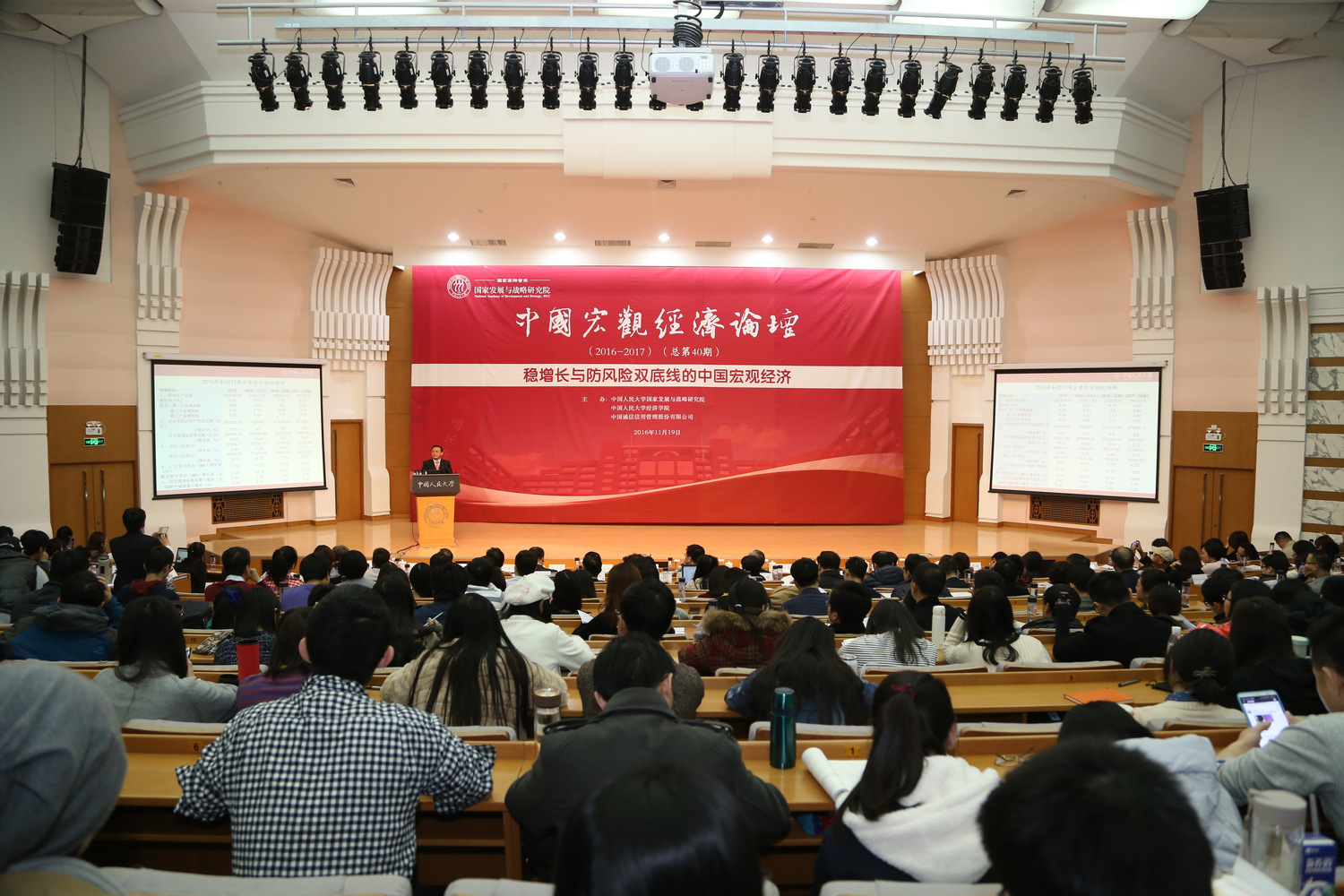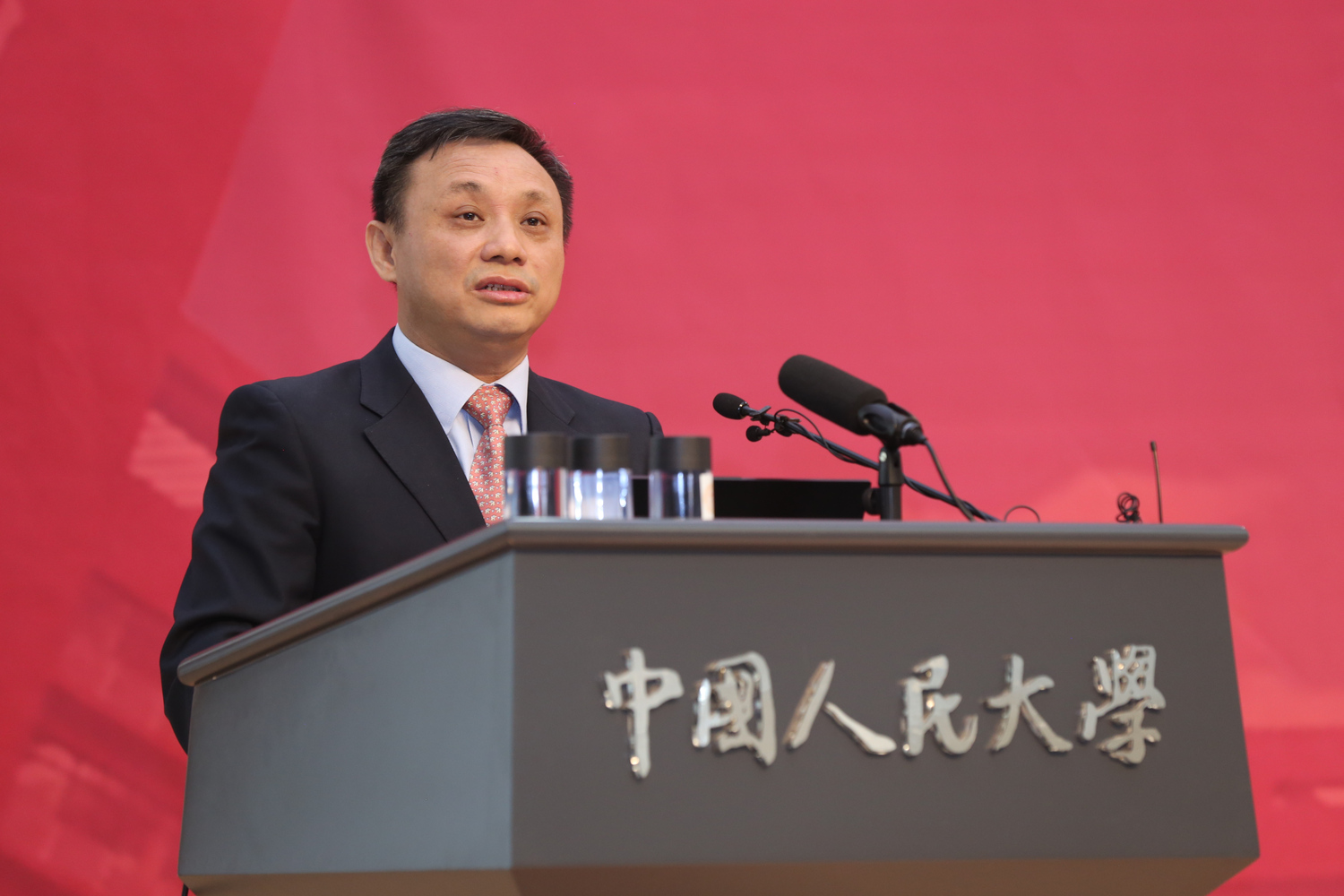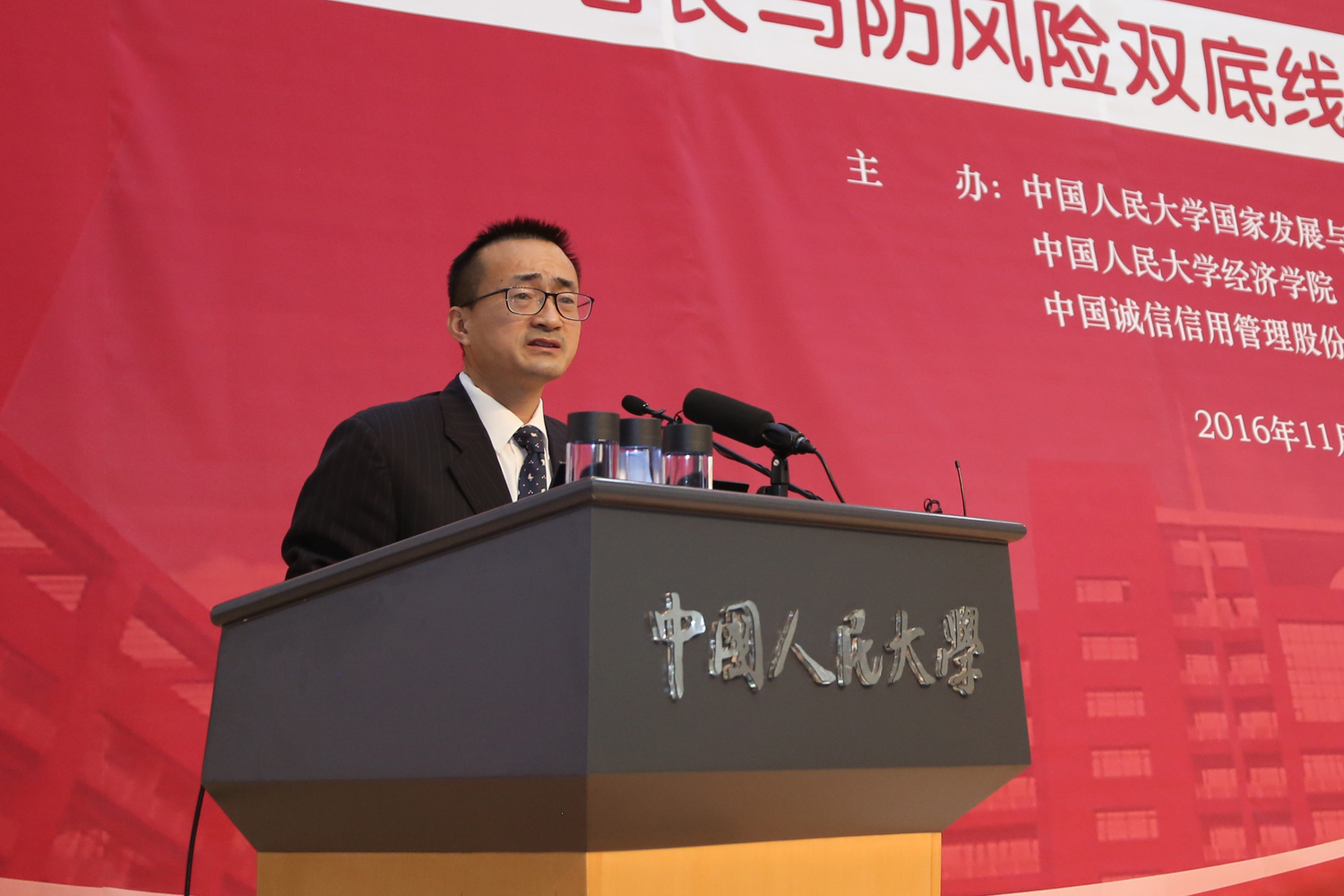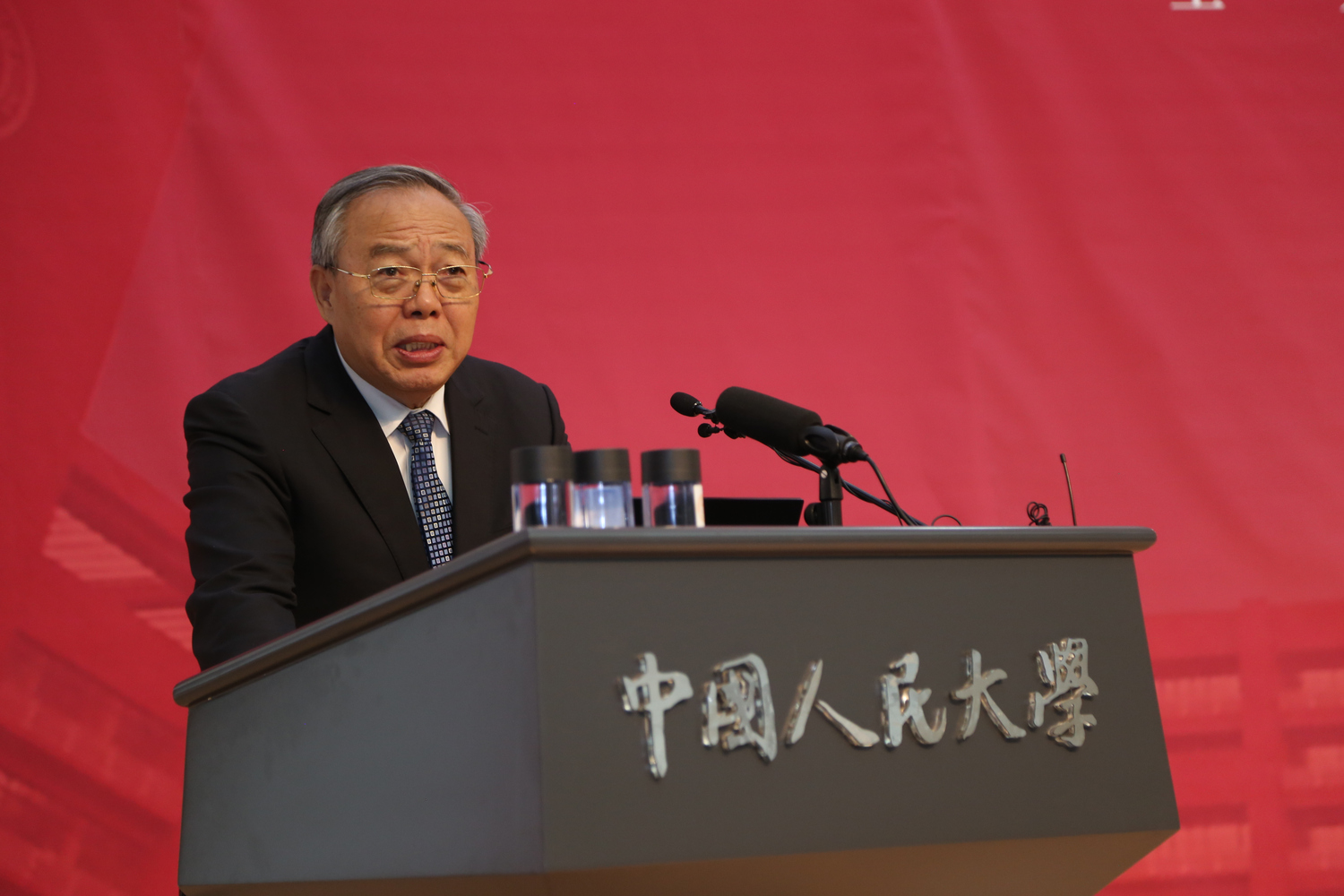 Research Update
Research Update
19
Nov

China Macro Economy Forum (2016-2017)
On Nov. 19, 2016, the report meeting of "China Macro Economy Forum (2016-2017)"jointly sponsored by the National Academy of Development and Strategy (NADS) and the School of Economics of Renmin University of China (RUC), and China Chengxin Credit Management Co.,Ltd. was held in RUC, the theme of which was "China's Macro Economy Supported by Double Bottom Lines of Maintaining Stable Growth and Guarding Against Risks".
Participants of the Forum included Liu Wei, President of RUC and Dean of NADS, Hu Naiwu, First-grade Professor at RUC, ZhengXinli, Vice Director of China Center for International Economic Exchanges and former director of the Policy Research Office of CPC Central Committee, Cao Yuanzheng, Chairman of BOC International Research Co., Ltd. and Senior Research Fellow of NADS, Gao Peiyong, Committee Member of Academic Divisions of CASS and President of National Academy of Economic Strategy, Wang Qing, Partner, President and Chief Economist of Shanghai Chongyang Investment Management Co.,Ltd., Yang Ruilong and Mao Zhenhua, Joint Directors of the Institute of Economic Research of RUC, Liu Yuanchun, Executive Dean of the NADS and Vice Director of the Institute of Economic Research of RUC, Professor Liu Fengliang, Managing Vice Director of and Director of the Personnel Department of the Graduate School, RUC and other experts and scholars.

Yang Ruilong, Joint Director of the Institute of Economic Research of RUC
Session I of the Forum was moderated by Yang Ruilong, Joint Director of the Institute of Economic Research of RUC.

Liu Wei, President of RUC and Dean of the NADS
In addressing the Forum, President Liu Wei expressed warm welcome and sincere thanks to all distinguished guests present at the meeting. He stated that over the past 10 years since its establishment, China Macro Economy Forum has always upheld the direction and strategy of serving national strategy, basing on national conditions and making contributions to study of economic situations and development of China. He also mentioned in particular that over the past 10 years, the Forum provided corresponding theoretical basis and scientific judgment for fast yet steady completion of main tasks of the 11th Five-Year Plan and the 12th Five-Year Plan, and hoped that the Forum will give play to academic power in the decisive stage of finishing building a moderately prosperous society in all respects as ever. Insisting on application of the research achievements and academic viewpoints to the great practice of developing China’s economy, the Form presents academic influence expanding increasingly and has become an important academic brand of RUC and an important achievement and mark of RUC in building "National High-end Think Tank". President Liu Wei fully affirmed achievements of NADS in recent years and expressed his best wishes for future development and construction of NADS. Finally, President Liu Wei pointed out that the theme of the Forum this year is "China's Macro Economy Supported by Double Bottom Lines of Maintaining Stable Growth and Guarding Against Risks", and hoped that all experts and scholars present at the meeting can speak out freely the views on how to maintain stable growth and guard against risks as a very important issue facing complicated economic situation and properly judge current situations of economic development of China, and offer advice on future economic trend of China for macro decisions of the Central Government.

Mao Zhenhua, Joint Director of the Institute of Economic Research of RUC
Mao Zhenhua, Joint Director of Institute of Economic Research, released the theme report of the Forum on behalf of the topic group: “Analysis and Forecast of China's Macro Economy(2016-2017)——China's Macro Economy Supported by Double Bottom Lines of Maintaining Stable Growth and Guarding Against Risks”.
The Report points out that the Year 2016 is the first year of the "13th Five-Year Plan" and of the supply-side structural reform. Impacted by multiple factors such as weak economic recovery around the world, adjustment of China’s growth cycle and serious overcapacity, China’s economic growth still faces the downward pressure. However, with China’s continuous proactive fiscal policy and intensified efforts to tackle tough problems of reform, its economic growth has presented the sign of stable bottom. In the first three quarters, China witnessed GDP growth of 6.7%, industrial production slower but to be steady, enterprise profit growth change from negative value to positive value and continuous growth, moderate rise of consumer prices, and lower deflation in industrial field. In September, PPI changed to a positive value from a negative value. However, the foundation for such economic steadiness driving by government-led power is not solid: some deep-level problems in economic operation has remained unsolved, M2-M1 scissors difference has kept wider, and monetary policy marginal effect has decreased progressively; asset bubble problem has become more striking and partial risk worsen, bubbles in real estate field having serious influence on macro economy and people's livelihood have accumulated constantly, and real estate price has soared; private investment growth has fallen; structural risk of debt has become serious increasingly, particularly in non-financial enterprises, among which problems of overcapacity and partial supply insufficiency are still severe, etc. Due to the concern about bubbles and risks, China’s macro regulation keynote was shifted to guarding against risks from maintaining stable growth. The Political Bureau’s meetings clearly pointed out that the "monetary policy should inhibit asset price bubble and prevent financial risk "; with more and more stricter real estate regulation policies mapped out, the real economy rebound driven by real estate market recovery is facing the risk of fall, and relevant data show lower growth of land purchase and new housing construction area in Q3. Overall, with the hysteresis effect of slower growth of real estate investment, the situation of growth of macro economy in the first three quarters will continue in Q4, but downward pressure will come in the first half of next year (2017). Comprehensively considering whole-year situations and according to model-base forecast, 2016’s economic growth will be 6.7% and CPI growth 2% or so.
The year of 2017 will be one of continuous bottom forming of China’s economy. In the long run, the power sources supporting high growth of China’s economy over the past 30 plus years have become poorer at different levels, globalization dividend has been exhausted, industrialization dividend has decreased progressively, and demographic dividend has been reversed with approaching of the bottom of the dependency ratio, coming Lewis Turning Point and fall of savings rate. During the "13th Five-Year Plan" period, the economic growth potential will be weaker to some extent, and potential economic growth rate may fall beyond 6.5%. In the mid-short run, the U.S. economic data are mixed, with less strong growth power and potential impact of policy uncertainty of the new government; EU, besides its own structural problems, will be further impacted by Brexit, meaning hard recovery of foreign demands. So the growth power will depend on domestic demands. Domestic demands depend on residents’ income and consumption habit, etc., which will be steady compared with economic growth; investment demands depend on growth of the investment in three major fixed assets of capital construction, real estate and manufacturing industry, while change of industrial adjustment cycle determines that it will be hard to meet obvious improvement of the investments in real estate and manufacturing industry, and infrastructure investment growth, main force in maintaining stable growth, will be limited; in view of industrial development, new powers will still be hard to replace old powers in driving economic growth, and whether the supply-side reforms such as "Cutting Overcapacity", etc. can make continuous and substantial progress will still determine whether the bottom of China’s economy can be reached; in the course of development to service-oriented economy, the fact that the labor productivity of service industry is lower than that of secondary industry will restrain lift of social labor productivity. From the perspective of debt, current path of China to maintain stable growth remains "Debt-Investment"–driven mode, which determines that China’s total debt in 2017 will climb as ever. Considering the repayment cycle, the beginning of 2017 will perhaps be the "Minsky Moment" needing vigilance. In addition, fluctuation of China’s political cycle will also make influence on fluctuation of its economy. Comprehensively, in 2017 China's macro economy will still be in the stage of bottom forming and the year 2018 may meet rebound from the final bottom. According to model-based forecast, in 2017 China's macro-economy GDP will be 6.5% and CPI 2.1%.
Meanwhile, in 2017 China’s macro economy will still face 7 major difficulties, particularly in real estate sector still in the adjustment cycle, downward pressure and structural risk of debt due to policy adjustment will be more serious, indicating that deep-level problems in China’s economy have not been solved but worsened. We think that 7 major uncertainties are substantially determined by the main path of China’s economic growth, namely "Debt-Investment"-driven mode; money is supplied to central and local state-owned enterprises in manner of debt with bank loan as main item, to fuel massive infrastructure construction offered by the government; real estate-oriented investment projects always create problems of asset bubble, high enterprise debt and rising debt ratio while lifting economic growth; decrease of rate of return on investment and of efficiency of fund use in regardless of real economy or virtual economy, has gradually weakened utility of the "Debt-Investment"-driven mode, and the high risk from high debt has become a great threat to economic stability.
Since the financial crisis, China’s total debt size and debt ratio have kept rising, and debt risk has mainly concentrated in state-owned and state-holding enterprises in non-financial sector; due to implicit guarantee, the debt risk of the government, particularly of local governments, has exceeded the expectation, and the generalized government liability ratio including liabilities of urban infrastructure investment enterprises has been higher than 109%. If state-owned enterprises are included, the generalized government debt will be more serious, up to 163.2%. In view of international comparison, China’s household sector liability ratio is lower than that of the U.S. and of Japan, but higher than that of the countries at the same development level as it. In addition, the household sector’s debt expansion speed is far higher than other countries, and the debt structure features mid/long-term home loan. Compared with the level of the U.S. and of Japan before the financial crisis, there will be limited room for home-loan-driven leverage in household sector. In fact, currently China’s total debt has been at a "critical point". In view of the debt ratio of non-financial enterprise sector, the total debt ratio level (254.9%) has been far higher than the debt ratio (77.7%) of Mexico before the financial crisis and the debt ratio level (188.8%) of Thailand before the Asian financial crisis, lightly higher than the debt ratio (238.5%) of the U.S. before the financial crisis, and close to the debt ratio (262.1%) of Spain before the financial and economic crisis. Moreover, the leading economic indicators reflecting financial crisis such as credit expansion and credit gap, etc. have all come close to even exceeded those of all countries before the crisis. According to debt cycles of all relevant countries, not all credit expansion situations can trigger "Fisher-debt" cycle chain reaction. At such a critical point with systemic risk, currently the negative effect is short and non-continuous from regardless of the impact by bond market default or the tighter credit market financing, but, considering the higher and higher fragility and sensitivity of domestic financial system at present, a debt crisis even economic crisis that may be triggered by any unexpected external event cannot be excluded.
From the perspective of the world history of economic development and the experiences of main developed countries, crisis burst makes great impact to economy, but also means an opportunity for deep adjustment of resources misallocation. It is needed to objectively face the truth that China’s economy at present has developed some potential elements to cause economic crisis, but China has had the capacity to withstand debt crisis to certain extent given its current economic strength; what needs to be alerted is the uncontrollable state of development of expectation and confidence to certain extent. China still needs to guard against economic impact caused by debt crisis. Against the backdrop of continuous economic downward pressure and striking debt risk, China needs to restructure the macro regulation system under the double bottom lines of “maintaining stable growth and guarding against risks". To advance construction of the system, we need to correctly recognize proper balance between the short-term target and the mid/long-term target of macro regulation, and to prevent further aggravation of 6 major problems including risk in the process of risk mitigation.
Focusing on the macro regulation system, on the one hand, the strategic thought must clarify the logic order of "maintaining stable growth, guarding against risks and promoting reform", and the policy keynote needs to guarantee concerted progress of supply-side structural reform and demand-side management policy; maintaining stable growth is the precondition for mitigation of risk and the bottom line of creating more jobs and benefiting people's livelihood; economic growth should be able to bring rise of asset value, so as to improve enterprises’ asset liability structure and mitigate debt risk to certain extent. On the other hand, prevention and control of risk, particularly debt risk, is the key, and the bottom line to guarantee no economic crisis in China; solving the problem of high debt will not necessarily bring systemic crisis. As far as China’s situation concerned, credit expansion mainly occurs in state-owned economic sectors. As long as the government credit does not collapse, the debt market will be able to maintain, and there will still be certain policy room to guard against debt crisis. It is needed to point out that risk control does not mean simple deleverage, but adjustment of debt structure under the premise of stabilizing leverage growth. In view of policy level, it is needed to stably mitigate China’s debt risk under the goal of "maintaining stable growth and keeping the bottom line", continuously push ahead with category-based debt identification, and perfect the balance sheet of the state and all bodies at various levels; great shift should be used to realize debt transfer, and the Central Government should apply higher leverage moderately; the principles of marketization and institutionalization should be followed to mitigate short-term debt risk through application of debt-to-share instrument at due time; in addition, efforts should be made to continuously advance financial reform, particularly the package measures for capital market reform addressing “deleverage" at the macro level of China and for state-owned enterprises should be promoted fast. Continuous attentions should be paid to the momentum of real estate market, to prevent the bubble from expanding. Relevant real estate regulation policy should highlight structural characteristics and difference.

Liu Yuanchun, Executive Dean of NADS, RUC
Session II of the Forum was moderated by Liu Yuanchun, Executive Dean of NADS and Joint Vice Director of the Institute of Economic Research of RUC. All experts and distinguished guests present at the meeting carried out deep exploration and exchange of some issues on China's macro economy.

Zheng Xinli, Vice Director of China Center for International Economic Exchanges and former Director of the Policy Research Office of CPC Central Committee

Cao Yuanzheng, Chairman of BOC International Research Co., Ltd. and Senior Research Fellow with the NADS

Gao Peiyong, President of the National Academy of Economic Strategy, CASS

Wang Qing, Partner, President and Chief Economist of Shanghai Chongyang Investment Management Co.,Ltd.